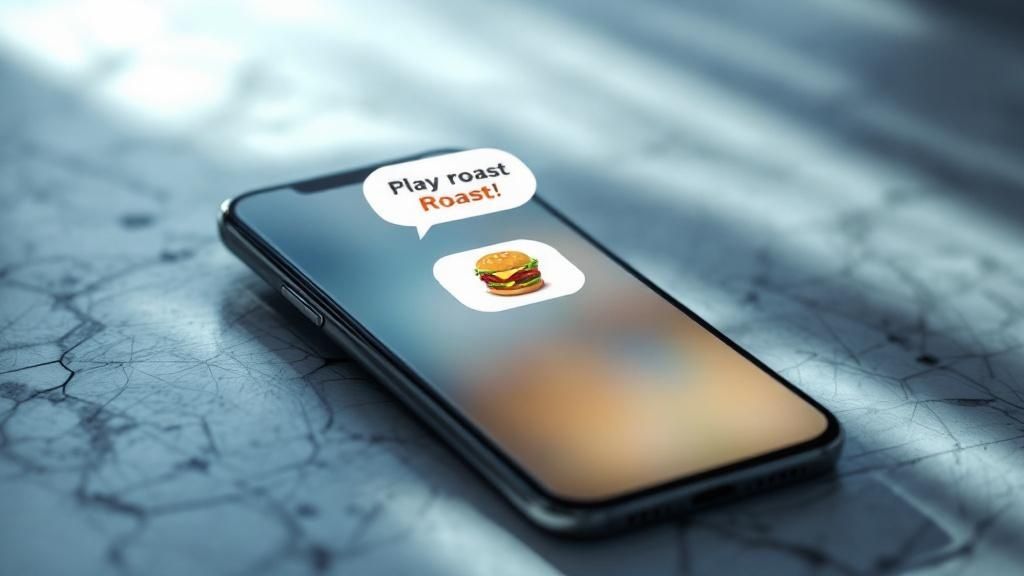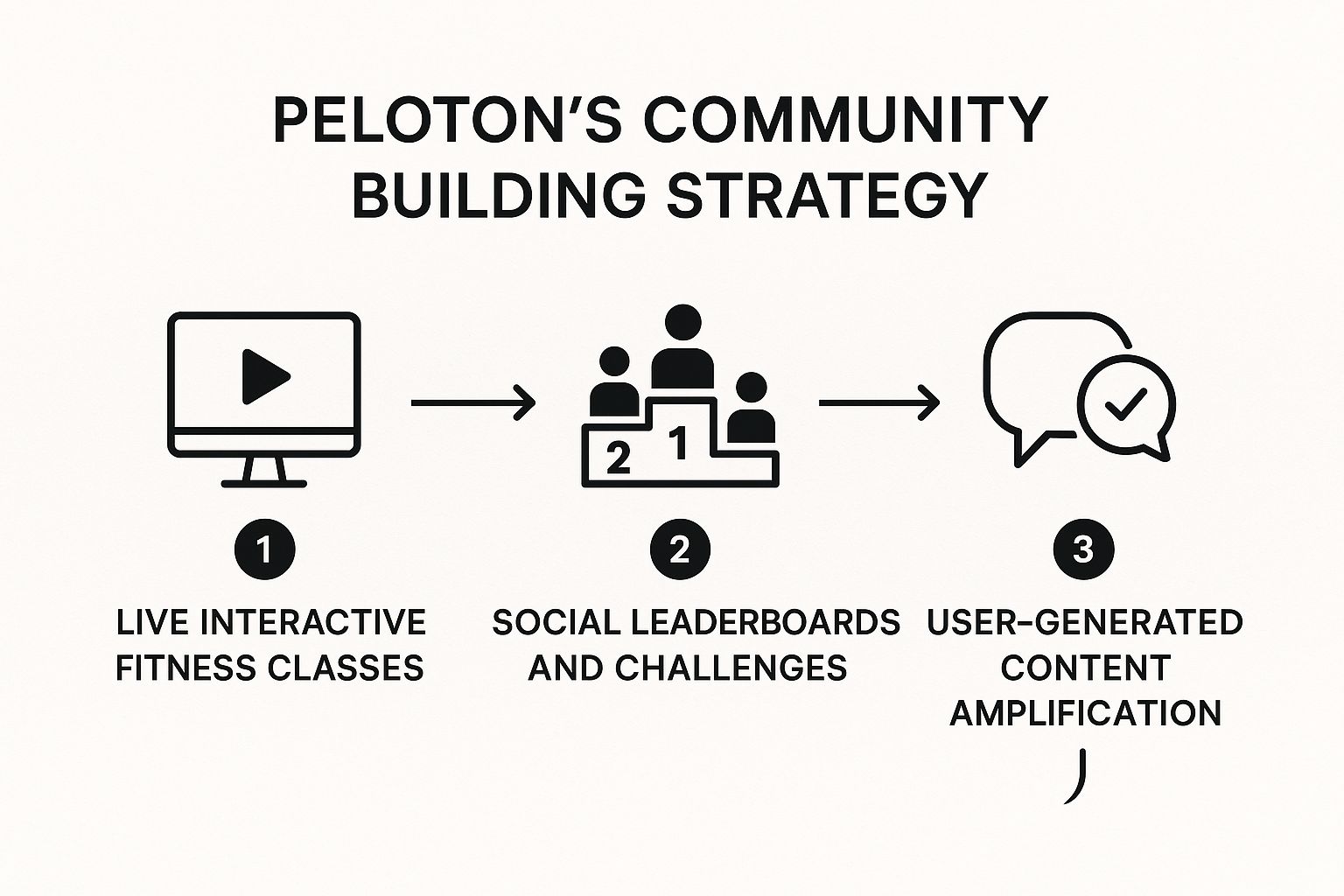In today's crowded digital marketplace, a well-defined plan is essential for survival. But what does a successful digital marketing strategy look like in practice? Generic advice falls short when you need concrete results. That's why we're moving beyond abstract theories to analyze the real-world tactics of industry-leading brands.
In this deep dive, you'll find a powerful digital marketing strategy example for every major channel. Each breakdown explores the specific objectives, the exact tactics used, and actionable takeaways you can apply to your own campaigns. Forget vague success stories; this is a behind-the-scenes look at the mechanics of what works.
Whether you're a seasoned marketer at a B2B SaaS company or a professional services firm refining your approach, these examples offer a clear blueprint for creating measurable impact and driving sustainable growth. We'll examine the strategies behind HubSpot's content empire, Canva's SEO dominance, and Airbnb's hyper-personalized email automation. This isn't just a list of what they did—it's a guide to how you can replicate their success. Let's break down what truly works.
1. Content Marketing Strategy: HubSpot's Educational Approach
HubSpot is a prime example of a content-first digital marketing strategy. Pioneering the concept of "inbound marketing," their approach revolves around attracting customers by creating valuable content and experiences tailored to them. Instead of interrupting potential buyers with ads, they provide free, high-quality educational resources that solve the audience's problems and establish HubSpot as a trusted authority. This builds a powerful lead generation engine fueled by organic search and brand loyalty.
Their entire ecosystem is designed to guide prospects through the buyer's journey. The strategy works by offering value upfront, capturing leads with gated content and free tools, and then nurturing those leads into customers.

Strategic Breakdown
HubSpot's success isn't just about volume; it's about strategic execution. They meticulously map content to different stages of the customer journey, from awareness to decision-making. This ensures that no matter where a potential customer is in their process, HubSpot has a relevant resource waiting for them.
Key Insight: The strategy's core is the "flywheel model," where providing exceptional value creates happy customers who, in turn, refer new business, creating a self-sustaining growth loop.
Here’s how their key assets function:
- HubSpot Blog: Acts as the top-of-funnel magnet, attracting millions of monthly visitors through SEO-optimized articles that answer common marketing, sales, and service questions.
- HubSpot Academy: Offers free certifications and courses, functioning as a powerful mid-funnel tool that not only educates users but also familiarizes them with HubSpot's software.
- Free Tools: Their free CRM and other marketing tools are lead-generation powerhouses, providing immediate value while seamlessly integrating users into the HubSpot ecosystem.
Actionable Takeaways for Your Business
To replicate this digital marketing strategy example, focus on becoming a resource, not just a vendor.
- Identify Pain Points: Use keyword research and customer interviews to discover what your audience is struggling with.
- Create Pillar Content: Develop comprehensive guides, reports, or tools around core topics relevant to your business. Break these down into smaller, related pieces of content like blog posts and social media updates.
- Offer Value for Free: Provide a free tool, a comprehensive eBook, or a valuable webinar in exchange for an email address. This is the first step in building a relationship and nurturing a lead.
2. Social Media Engagement Strategy: Wendy's Twitter Roasting Campaign
Wendy's revolutionized fast-food social media marketing by ditching corporate-speak for a bold, humorous, and sometimes savage Twitter personality. Their strategy centers on real-time engagement, witty comebacks, and roasting competitors. Instead of broadcasting ads, they create entertainment, transforming their social feed into a destination. This approach generates massive organic reach, builds a cult-like following, and keeps the brand culturally relevant.
This digital marketing strategy example works by personifying the brand, making it feel more like a friend you'd banter with than a faceless corporation. The authenticity and humor build a strong emotional connection with the audience, driving brand loyalty and top-of-mind awareness.

Strategic Breakdown
Wendy's success is a masterclass in understanding platform context and audience expectations. They recognized that Twitter users value authenticity, humor, and direct interaction. By leaning into this, they turned their feed into a must-follow account, generating earned media that traditional advertising could never buy.
Key Insight: The strategy's power lies in "brand-as-entertainer." By prioritizing engagement and personality over direct selling, Wendy's creates viral moments that embed their brand in popular culture.
Here’s how their key tactics function:
- Competitive Roasting: Famously targeting competitors like McDonald's over their frozen beef, Wendy's creates viral moments that highlight their "fresh, never frozen" value proposition in a memorable way.
- Audience Interaction: From witty replies to customer questions to the famous "#NuggsForCarter" campaign that became the most retweeted tweet ever, they make their followers part of the story.
- Reactive Humor: The social media team actively monitors trends and conversations, allowing them to jump in with timely, relevant commentary that feels spontaneous and authentic.
Actionable Takeaways for Your Business
To leverage a similar strategy, you must first define a unique and ownable brand voice. Not every brand can be a "roaster," but every brand can be more human.
- Define Your Brand Personality: Is your brand witty, helpful, sophisticated, or playful? Document this and ensure your social media team is thoroughly trained.
- Monitor and Engage: Use social listening tools to track brand mentions, industry keywords, and competitor activity. Look for opportunities to engage in a meaningful and authentic way. Explore these social media content ideas to boost engagement for inspiration.
- Empower Your Team: Give your social media managers the freedom to be creative and respond in real-time, but have clear guidelines and crisis management protocols in place. Authenticity can't be scripted.
3. Influencer Marketing Strategy: Daniel Wellington's Micro-Influencer Approach
Daniel Wellington provides a masterclass digital marketing strategy example of how to scale a global brand with a targeted influencer-first approach. Instead of investing heavily in traditional advertising or celebrity endorsements, the watch brand built its empire by collaborating with thousands of micro and mid-tier influencers. Their strategy centered on gifting watches in exchange for authentic-looking posts, creating an avalanche of user-generated content that felt organic and relatable to their target audience.
This method flooded social media feeds, particularly Instagram, with aspirational lifestyle photos featuring their watches. By equipping each influencer with a unique discount code, they created a sense of exclusivity and urgency while also building a powerful, trackable sales channel that fueled explosive growth.

Strategic Breakdown
Daniel Wellington’s success was not accidental; it was a highly replicable system built on scale and authenticity. They understood that the collective voice of many smaller, highly engaged communities was more powerful and cost-effective than a single, expensive celebrity shout-out. This allowed them to dominate the visual narrative for minimalist watches online.
Key Insight: The strategy's brilliance lies in its ability to generate social proof at scale. Seeing the product in countless authentic lifestyle settings created a powerful perception of widespread popularity and desirability.
Here’s how their key assets functioned:
- Micro-Influencer Army: By partnering with influencers who had high engagement rates rather than just massive follower counts, they ensured their message reached dedicated and trusting audiences.
- User-Generated Content (UGC) Engine: The use of the #DanielWellington hashtag turned every influencer post into a piece of marketing collateral, creating a vast, searchable library of authentic product showcases.
- Trackable Discount Codes: Unique codes for each influencer served a dual purpose: they incentivized purchases for followers and provided Daniel Wellington with clear, actionable data on which partnerships were driving the most sales.
Actionable Takeaways for Your Business
To leverage this influencer-focused digital marketing strategy example, focus on building authentic relationships and scalable systems.
- Prioritize Engagement Over Reach: Identify micro-influencers in your niche whose audience genuinely trusts their recommendations. A smaller, engaged following is often more valuable than a large, passive one.
- Systematize Your Outreach: Create a clear, simple proposition for influencers. Gifting products and providing unique discount codes is a proven model that is easy to manage and scale.
- Track Everything: Implement a system to monitor performance. Use unique affiliate links or discount codes to attribute sales directly to specific influencers, allowing you to identify and build long-term relationships with top performers.
4. Email Marketing Automation: Airbnb's Behavioral Trigger Strategy
Airbnb exemplifies a masterful digital marketing strategy example built on sophisticated email marketing automation. Their approach moves beyond generic newsletters, focusing instead on behavioral triggers to deliver highly relevant, timely, and personalized communications. By tracking user actions like searches, wish-listed properties, and booking processes, Airbnb creates an automated system that feels uniquely personal and helpful to each user.
This strategy is powerful because it intercepts users at critical moments in their journey. Whether it's reminding them of a property they viewed or offering local suggestions for an upcoming trip, each email serves a clear purpose, nurturing the user relationship and gently guiding them toward conversion and retention.
Strategic Breakdown
Airbnb’s email success is rooted in its deep understanding of the customer lifecycle and user intent. The automation is designed not just to sell, but to enhance the entire travel experience, from initial discovery to post-trip engagement. This builds immense trust and keeps users engaged with the platform long-term.
Key Insight: The core of this strategy is using data-driven triggers to make a large-scale platform feel like a one-on-one conversation. Relevance and timing are prioritized over volume, ensuring each email adds value.
Here’s how their key email assets function:
- Abandoned Booking Recovery: When a user starts but doesn't complete a booking, automated emails are sent with personalized property suggestions and a clear call-to-action to finish their reservation.
- Wishlist & Search Reminders: If a user saves properties to a wishlist or frequently searches for a destination, Airbnb sends timely reminders and updates about those listings, keeping them top-of-mind.
- Lifecycle & Onboarding Emails: New users receive a welcome series with local guides and tips, while post-trip emails prompt for reviews and suggest future destinations, fostering a continuous engagement loop.
Actionable Takeaways for Your Business
To implement this type of digital marketing strategy example, focus on automating responses to user behavior.
- Map Key User Actions: Identify critical touchpoints where a timely email could make a difference, such as cart abandonment, prolonged inactivity, or repeat purchases.
- Segment Your Audience: Go beyond basic demographics. Create segments based on browsing history, purchase frequency, and engagement level to send more targeted messages. You can learn more about building a winning email marketing campaign on twelverays.agency.
- Leverage Dynamic Content: Use personalization tokens and dynamic content blocks to insert relevant information like viewed products, user names, or location-specific offers directly into your email templates.
5. SEO Content Strategy: Canva's Template and Design Resource Hub
Canva has mastered the art of attracting millions of users through a powerful SEO-driven content strategy. Their approach is built on providing immense value through free design templates, tools, and educational resources that directly address user needs. By targeting an enormous range of design-related keywords, from "business card templates" to "how to create a logo," they have built a massive organic traffic engine that converts searchers directly into platform users.
This strategy positions Canva not just as a tool, but as the go-to destination for anyone with a design-related query. They expertly capture user intent at every stage, offering practical solutions that naturally lead people to use their product, solidifying their dominance in search engine results for countless design terms.
Strategic Breakdown
Canva’s digital marketing strategy example is a masterclass in product-led content. Instead of just writing about design, they create content that is the solution, like a usable template or a dedicated tool page. This seamless integration of content and product creates an incredibly low-friction user experience, turning search intent directly into product engagement.
Key Insight: The core of their strategy is "search-led product development," where popular search queries and user needs directly inform the creation of new templates, tools, and content hubs.
Here’s how their key assets function:
- Free Template Galleries: These are massive, SEO-optimized landing pages targeting specific high-intent keywords like "resume templates" or "Instagram post templates." Each gallery serves as a powerful entry point to the Canva editor.
- Canva Design School: A comprehensive resource hub featuring tutorials and courses that answers "how-to" questions, positioning Canva as an educational authority and building user confidence in their platform.
- Design Resource Blog: This content addresses broader industry topics and design trends, capturing top-of-funnel traffic and establishing brand relevance beyond their immediate toolset.
Actionable Takeaways for Your Business
To replicate this SEO-centric approach, focus on creating content that solves a problem with a practical resource.
- Target User Intent: Go beyond basic keywords. Identify what users are trying to accomplish and create tools or resources (like calculators, templates, or checklists) that help them achieve it.
- Create Comprehensive Pillar Pages: Build in-depth resource hubs around your core services or products. Internally link from related blog posts back to these pillar pages to build their authority.
- Optimize for Snippets and Rich Results: Structure your content with clear headings, lists, and tables to increase your chances of being featured in Google's rich results, driving higher click-through rates.
6. Video Marketing Strategy: Dollar Shave Club's Viral Launch Campaign
Dollar Shave Club exploded onto the scene with a digital marketing strategy example that proved a single, well-executed video could disrupt an entire industry. Their approach centered on a hilarious, low-budget launch video that went viral, using humor and a direct-to-consumer value proposition to challenge established giants like Gillette. Instead of traditional advertising, they created entertainment that also happened to sell a product.
This strategy worked by building an authentic, relatable brand personality that instantly connected with its target audience. The video's massive success generated enormous brand awareness and drove 12,000 sign-ups in the first 48 hours, demonstrating the power of virality when paired with a clear call-to-action.
Strategic Breakdown
Dollar Shave Club's genius was in wrapping a simple, powerful value proposition ("a great shave for a few bucks a month") inside a Trojan horse of comedy. The video was engineered for social sharing, directly addressing audience pain points (the cost and hassle of buying razors) in a way that felt like an inside joke, not a sales pitch.
Key Insight: The strategy succeeded by prioritizing brand personality and entertainment over slick production. It proved that authenticity and a strong message could outperform massive advertising budgets.
Here's how their key assets functioned:
- The Launch Video: Titled "Our Blades Are F***ing Great," this was the centerpiece. It used CEO Michael Dubin's deadpan delivery to create an unforgettable, shareable piece of content that established the brand's irreverent tone.
- Social Media Amplification: The video was perfectly optimized for platforms like YouTube, Facebook, and Twitter. Its humor and surprising nature encouraged viewers to share it organically, creating a viral loop.
- Clear Call-to-Action: The video ended with a simple and direct CTA, funneling the massive influx of viewers directly to their website to sign up, converting viral buzz into tangible business results.
Actionable Takeaways for Your Business
To leverage this type of video marketing, focus on personality and a clear message. Explore further insights on the power of video in social media marketing to enhance your campaigns.
- Lead with Personality, Not Polish: Don't be afraid to show your brand's human side. Authentic, low-budget videos can often resonate more than highly-produced corporate ads.
- Solve a Clear Problem: Your video's humor or entertainment value should support a core message that solves a real customer pain point. Make your value proposition impossible to miss.
- Design for Sharing: Create content that people will want to share with their friends. This often means being funny, surprising, or incredibly insightful. Ask yourself: "Would I send this to a friend?"
7. Retargeting and Personalization Strategy: Amazon's Dynamic Product Recommendations
Amazon is a masterclass in using data to drive sales through a sophisticated retargeting and personalization strategy. Their approach is built on a deep understanding of user behavior, using browsing history, past purchases, and even items left in a cart to serve hyper-relevant product recommendations. This creates a seamless and predictive shopping experience that feels uniquely tailored to each individual.
The strategy’s power lies in its omnichannel execution. Whether a user is browsing the website, checking their email, or visiting another site, Amazon’s personalized suggestions follow them, keeping relevant products top-of-mind and significantly boosting conversion rates and customer lifetime value.
Strategic Breakdown
Amazon's strategy goes beyond simple retargeting; it’s a fully integrated personalization engine. By analyzing vast datasets, their recommendation algorithm predicts what a customer is likely to buy next, creating a powerful system for upselling and cross-selling that drives a significant portion of their revenue.
Key Insight: The core of this digital marketing strategy example is collaborative filtering, an algorithm that suggests items based on what similar users have purchased, effectively creating a "people who bought this also bought..." engine.
Here’s how their key assets function:
- On-Site Personalization: The homepage, product pages, and checkout process are all dynamically customized. Sections like "Inspired by your shopping trends" and "Frequently bought together" are prime examples.
- Dynamic Email Campaigns: Amazon uses automated emails to recover abandoned carts, suggest products related to recent views, and notify users of deals on items they’ve shown interest in.
- Display Ad Retargeting: Personalized display ads featuring products a user has viewed are shown across the web, reminding them of their interest and encouraging them to return and complete the purchase.
Actionable Takeaways for Your Business
To leverage personalization, focus on collecting and using customer data to create more relevant experiences.
- Implement Robust Tracking: Use tools like Google Analytics and tracking pixels to collect data on user behavior across your website and other digital channels.
- Segment Your Audience: Group users based on behaviors like pages visited, items viewed, or purchase history. This allows you to create more targeted and effective campaigns.
- Automate Your Follow-Up: Use marketing automation to trigger personalized emails for abandoned carts or follow-ups based on specific products viewed. Start simple and build complexity over time.
8. Community Building Strategy: Peloton's Connected Fitness Ecosystem
Peloton's digital marketing strategy example is a masterclass in modern community building, transforming a solo activity like home fitness into a deeply social and connected experience. Their approach hinges on creating a powerful ecosystem where users feel part of a collective movement, motivated not just by personal goals but by shared achievement and instructor encouragement. This turns customers into passionate brand advocates, driving immense organic growth and brand loyalty.
The strategy combines high-quality fitness content with interactive social features. Live classes, competitive leaderboards, and instructor-led social media engagement build a sense of belonging that extends far beyond the workout itself, fostering a loyal community that actively promotes the brand.
This diagram illustrates Peloton's core process for building its engaged community.
The flow highlights how live interaction and social competition are harnessed to inspire user-generated content, which ultimately amplifies the brand's reach.
Strategic Breakdown
Peloton's success lies in its ability to cultivate genuine human connections in a digital environment. They treat their instructors as influencers and community leaders, empowering them to build personal followings that strengthen the entire network. This focus on personality and interaction makes the experience feel personal and motivational, rather than transactional.
Key Insight: The strategy's brilliance is its ability to manufacture a sense of shared experience. By celebrating milestones and facilitating interactions, Peloton makes every user feel seen and valued within a larger group.
Here’s how their key assets function:
- Live Classes and Leaderboards: These create real-time energy and friendly competition, replicating the motivating atmosphere of an in-person studio class and encouraging repeat engagement.
- Instructor Social Presence: Instructors like Robin Arzón and Ally Love act as brand ambassadors, building authentic relationships with members on social media, which strengthens the user's emotional connection to Peloton.
- #PelotonFam Hashtag: This user-driven hashtag centralizes community conversations on platforms like Instagram and Facebook, allowing members to share progress, offer support, and amplify brand messaging organically.
Actionable Takeaways for Your Business
To build a community-centric digital marketing strategy, focus on facilitating connections and celebrating your users.
- Invest in Charismatic Leaders: Identify or empower individuals within your company or community who can act as authentic, engaging figureheads.
- Create Member Recognition Programs: Systematically celebrate user milestones, achievements, or contributions. This could be as simple as a social media shout-out or a "member of the month" feature.
- Facilitate User Connections: Build features or forums that allow your customers to interact with one another. This could be a dedicated Slack channel, a private Facebook group, or user profiles within your platform.
Digital Marketing Strategy Examples Comparison
From Inspiration to Implementation: Your Next Steps
We've journeyed through a powerful lineup of digital marketing strategy examples, from HubSpot's content empire to Peloton's community-driven ecosystem. Each case study, whether it’s Canva’s SEO dominance or Wendy's audacious social media presence, offers a masterclass in strategic execution. While their tactics and channels vary wildly, a set of core principles unites them all.
The most crucial takeaway is that a successful strategy is never a one-size-fits-all template. It’s a tailored solution born from a deep, almost obsessive, understanding of a specific audience. Amazon's personalization engine works because it anticipates individual user needs, just as Dollar Shave Club’s viral video succeeded by speaking the authentic language of its target demographic.
Synthesizing the Core Principles
So, how do you move from analyzing these examples to building your own winning formula? It begins by internalizing the strategic DNA shared by these industry leaders.
- Audience-Centricity: Every successful campaign began with the customer, not the product. They solved a problem, answered a question, or provided entertainment. Your first step is always to define who you are serving and what they truly value.
- Clear, Measurable Objectives: Vague goals like "increase brand awareness" were replaced with specific targets. Whether it was Daniel Wellington tracking influencer-driven sales or Airbnb monitoring re-engagement rates from automated emails, every action was tied to a measurable outcome.
- Authentic Brand Voice: Authenticity was the non-negotiable ingredient. Wendy's snark, HubSpot's helpfulness, and Peloton's inspirational tone are all deliberate and consistent. This distinctive voice builds trust and creates a memorable brand identity that stands out in a crowded market.
- Value-First Approach: The common thread weaving through every digital marketing strategy example is the commitment to providing genuine value before asking for a sale. This could be educational content, a powerful free tool, or a supportive community.
Your Action Plan for Strategic Growth
Viewing these case studies as inspiration, not a rulebook, is the key to unlocking your own growth. Your next steps shouldn't be to copy Wendy's Twitter strategy but to ask, "What is our unique brand voice, and where can we best express it to engage our audience?"
Start by conducting a strategic audit of your current efforts. Where are the gaps? Are your objectives clearly defined and tied to business goals? Are you leveraging channels that align with your audience's behavior and your brand's strengths? Use the frameworks and insights from these examples as a diagnostic tool to pinpoint opportunities for innovation and optimization in your own marketing. The ultimate goal is to build an integrated, data-driven system where each component works in harmony to drive sustainable growth.
Ready to translate these powerful insights into a customized strategy that drives measurable results for your business? At Twelverays, we specialize in crafting and implementing data-driven marketing frameworks that connect with your audience and deliver real ROI. Let us help you build your own success story.
Learn more about our strategic marketing services at Twelverays





